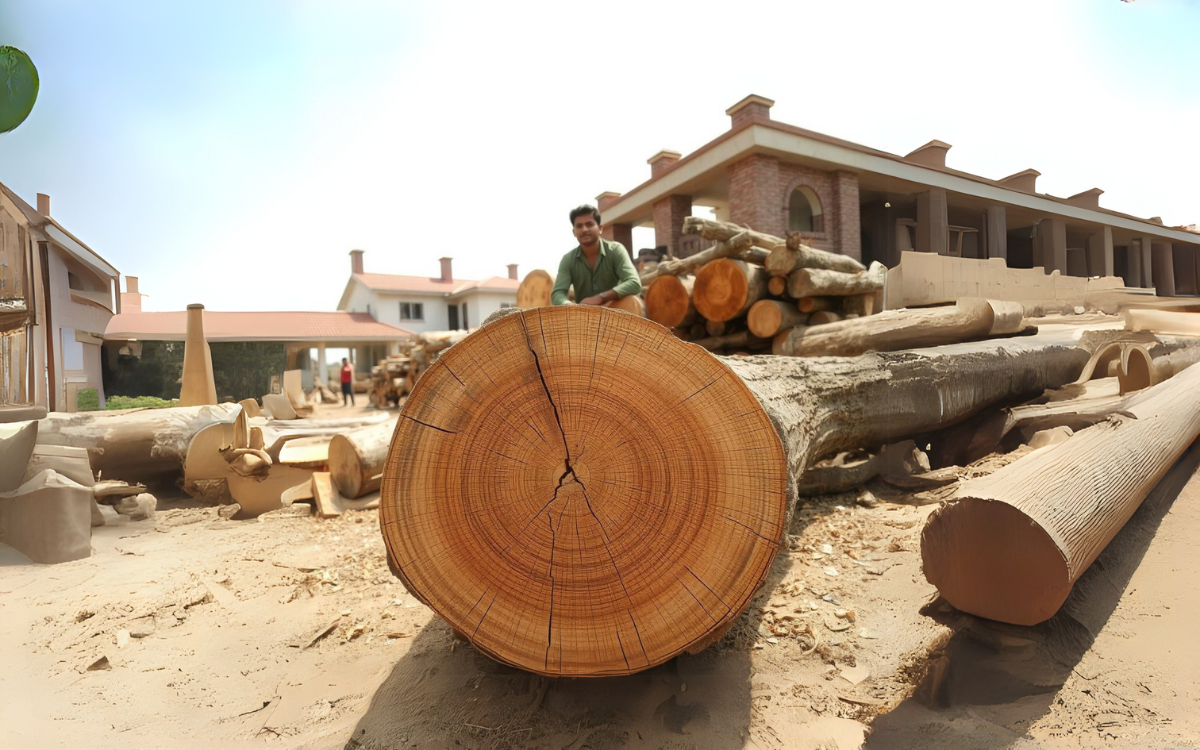Wood has always represented a timeless choice for furniture, building, and interior design. Among the more common varieties that come with their sets of peculiarities are Teak Wood and Thermo wood. Whether the objective is to invest in durable furniture or to have environmentally friendly wood options, knowing what distinguishes one from the other will help in making an informed choice. So, let us go through the features, benefits, and applications of Teak Wood and Thermo wood, along with aspects such as teak wood price, applications, and source options, including teak wood planks and teak wood suppliers. Further, the blog will provide insights on the differences between teak and thermo wood and which one would be suitable for your use.
What is Teak Wood?
Teak Wood is called Sagwan Wood in India. It is considered one of the most durable and valuable hardwoods in the world. Derived from the Tectona grandis tree, it is valued for its strength and capability of resisting water with the help of its natural oils, making it also a little resistant to pests and rot. Teak is available in natural forest teak wood as well as plantation teak wood varieties.
Prominent Features of Teak Wood:
There are many features of teak wood which make them stand out from the rest which is hwy it is preferred by many people for the cladding use.
- Extremely Durable: Can stand very extreme weather conditions, and hence an ideal choice for outdoor use.
- Water Repellent: The natural oil content of the wood works as a sealant, making it naturally water-resistant.
- Termite Resistance: Dense grain structure along with oils frustrates the activities of termites and other pests.
- Finer Appearance: Golden brown color with lovely grains, used further with natural teak veneer for premium finishes.
What Is Thermo wood?
Thermo wood is not a type of tree, rather a wood that has been thermally modified. It is produced by heating the softwood, which is usually pine or spruce) to high temperatures (160–230°C) in a controlled environment, enhancing its durability and stability. This treatment changes the wood’s chemical and physical properties without the use of chemicals, making it eco-friendly.
Prominent Features of Thermo wood:
Thermo wood is pretty durable and other than this there are many key features which makes it one of its kind wood type. Scroll down to learn more.
- Improved Stability: Reduced moisture content makes it less prone to swelling or warping.
- Enhanced Durability: Heat treatment increases resistance to fungi and decay.
- Lightweight: Easier to handle and install compared to hardwoods.
- Sustainable: Made from fast-growing trees using an eco-friendly process.
Teak Wood vs Thermo wood – A Detailed Comparison
| Feature | Teak Wood | Thermo wood |
| Origin | Natural hardwood (Sagwan wood) | Thermally modified softwood |
| Durability | Extremely high (50+ years) | Moderate to high (20–30 years) |
| Water Resistance | Naturally resistant | Improved through thermal treatment |
| Appearance | Rich golden-brown, elegant grains | Dark brown after treatment, less distinct grain |
| Weight | Dense and heavy | Lighter than teak |
| Cost | Expensive (Teak wood price depends on grade & origin) | More affordable |
| Maintenance | Minimal (oiling for appearance) | May require more upkeep outdoors |
| Environmental Impact | Available in plantation teak (sustainable option) | Highly sustainable |
| Use | Furniture, decking, shipbuilding, flooring | Cladding, sauna, paneling, exterior décor |
Benefits of Teak Wood
- Longevity: Products made from the best teak wood in India can last for generations.
- Luxury Finish: The natural oils and grain of sagwan wood make it a favorite in high-end furniture and flooring.
- Low Maintenance: Occasional polishing or oiling is enough to retain its shine.
- Versatility: Used in furniture, doors, window frames, and outdoor decking.
- High ROI: Though the teak wood price is high, it offers value over the long term.
Plantation Teak Wood
To promote sustainability, plantation teak wood is cultivated in managed forests. Unlike old-growth teak, plantation teak wood matures in 20-25 years and is slightly lighter in color and grain but still offers good durability. It’s widely used in modern construction and is a greener alternative.
Benefits of Thermo wood
Thermo wood is an eco-friendly choice that uses only heat and steam, eliminating the need for chemicals.
- Dimensional stability is ideal for environments with high humidity or shifting temperatures.
- Lightweight and easy to work with: Ideal for cladding, panelling, and interior design.
- Affordable: A great option for budget-conscious projects where teak may be too expensive.
- Aesthetic Appeal: Has a rich brown tone that looks like hardwood.
Common Uses of Teak Wood
Common uses for teak wood include furniture such as dining tables, chairs, mattresses, and cupboards.
- Decking and flooring: Extremely durable for both indoor and outdoor use.
- Doors and Windows: Weather-resistant and attractive.
- Marine applications: include boat decks and yacht interiors due to its water resistance.
Decorative Panels: Frequently used with natural teak veneer on walls and ceilings
Common Uses of Thermo wood
Thermo wood is commonly used for exterior cladding, particularly in modern architecture.
- Saunas and spa areas: Can withstand heat and humidity.
- Garden structures include fences, pergolas, and pots.
- Interior panelling: lightweight and attractive.
- Facade Work: An Eco-Friendly Choice for Contemporary Buildings
Teak Wood Prices and Market Trends
Teak wood prices in India vary greatly depending on quality, origin (Burma teak vs Indian plantation teak wood), and shape (logs, planks, or veneer). High-quality sagwan wood can cost ₹3,500 to ₹7,500 per cubic foot. Plantation teak provides a more inexpensive option while maintaining high quality.
For large-scale demands, procuring directly from teak wood suppliers or lumber yards that specialise in teak plantation wood can save money. Always check the grade and provenance to ensure authenticity and sustainability.
Conclusion
Depending on your project requirements and budget, both teak wood and thermo wood have distinct advantages. While teak wood, particularly plantation teak wood, represents the pinnacle of luxury, strength, and longevity, thermo wood stands out as an environmentally aware, cost-effective alternative with good durability and a refined finish. Understanding the distinctions between natural teak veneer for premium interiors and teak wood planks for outdoor applications provides a sensible and sustainable investment.
When sourcing, always look for reputable teak wood suppliers who provide certified items and a variety of options, including plantation teak. Whether you use traditional sagwan wood or contemporary thermo wood, your project will benefit from the inherent elegance and warmth that only wood can deliver.


